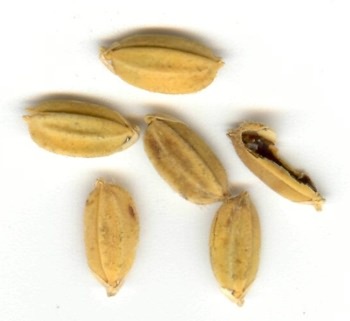Diseases
Tilletia horrida Tak. - Black Smut of Rice.
Systematic position.
Division Basidiomycota, class Ustomycetes, order Ustilaginales, family Tilletiaceae, genus Tilletia.Synonyms.
Neovossia horrida (Takah) Padwick & A. Khan., Tilletia barclayana (Bref.) Sacc & P. Syd.Biological group.
Biotrophic parasites.Morphology and biology.
Disease can be found in field during ripening of the rice. Attacks usually several spikelets, less often all spikelets of panicle. Instead of grains the smut bags are formed, having sooty black masses of spores. Spore masses can be found in ovaries; being concealed under glumes, they sometimes burst through at ripening. Spores dark-brow, globose to irregularly rounded, having sometimes short hyaline appendage, 21.7-31 x 26-35 ., and thick cover of conspicuous spines. During harvest the spores burst through smut bags and contaminate healthy kernels, residues, and soil. During the next growing season the spores germinate to form a promycelium bearing at top a single whorl of 20-60 filliform primary sporidia, 28-53 . long. They form numerous secondary sporidia spreading by wind and infecting ovaries of flowers. Two types of secondary sporidia are formed, obclavate-allantoid ones, 15-22 x 5 ., and filiform sporidia, 35-41 x 2 ..Ecology.
Spores keep viability during 3 years in stored grains. They also survive, passing through digestive tracts of domestic animals. Incidence of the disease is favored by light, sandy loam soils, frequent light showers, high relative humidity (85% or more), temperatures 25-30.C, and excessive rates of nitrogen applications.Distribution.
Everywhere in zones of cultivation of rice. In the former Soviet Union the disease has been registered in Primorski Territory and also in Syr Darya Region of Uzbekistan.Economic significance.
The disease has no economic significance in Russia. Sowing by the infected seeds without fungicide treatment may cause yield losses to 25%. Protective actions. Agronomical actions, i.e., spatial isolation of seed crops; sorting, cleaning, and treatment of seeds before sowing by fungicides; approbation of seed crops on smut incident, quarantine actions.Related references.
Abramov I.N. 1938. Diseases of agricultural plants in the Far East. Khabarovsk: Far East St. Reg. Ed., p. 167-172 (in Russian).Azbukina Z.M., Egorova L.N. & Oksenyuk G.I. 1986. Finding of Tilletia barclayana (Bref.) Sacc. et Syd. In Primorskii Territory. Mikologiya i fitopatologiya 20 (1): 3-5. (in Russian).
Dorofeeva L.L., Kodyakov A.A., Kratenko V.P., Lebedev М.B., Motovilin A.A. & Tikhonova N.A. 1992. Fungal diseases of rice. Tashkent: FAN. 94 p. (in Russian).
Dorofeeva L.L., Sizova T.P. & Shapovalova R.A. 1993. The phytopathologic state of rice crops in Central Asia. Mikologiya i fitopatologiya 27 (3): 62-66. (in Russian).
Hawksworth D.L., Kirk P.M., Sutton B.C. & Pegler D.N. 1995. Ainsworth & Bisby's Dictionary of the fungi. 8th edition. Kew, Surrey: Commonwealth Mycological Institute. 616 p.
© Gasich E.L.


